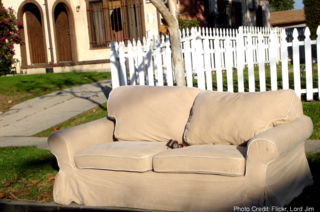When people ask me what the hardest chemical to avoid, I always think of toxic flame retardants in our furniture. It’s one thing to switch your water bottle, or a different low VOC paint, but buying a new couch is a more expensive purchase.
(Photo Credit: Lord Jim, via Flickr)
And even if you had the money to buy a new couch, finding one that is free of toxic flame retardants has been nearly impossible. When I was looking for a couch this fall for example, I had an option between buying an old vintage couch and a hand-made custom sofa for over $3,000.00. I went vintage.
The horizon looks a little more bright when it comes to furniture free of flame-retardants due to a new California standard. Rest assured, our work is still cut out for us on this issue, the buck doesn’t stop here.
Brief history
As you may remember the state of California passed a bill in the 1970s that required couch and furniture makers to use chemical flame retardants in their products. The result has been wide-spread, ubiquitous exposure to these harmful chemicals.
Scientific studies have raised concern for many chemical flame retardants including the commonly used “tris” which has been linked to cancer and was removed from children’s pajama’s in the 1970s.
The result has been a confusing marketplace for consumers – how are we able to find out which couches contain which chemicals? Or a common question I get is if there is a TB 117 tag on a product, does that mean it automatically contains flame-retardants (the answer to that is no, further confusing people.)
Due to our lax federal laws on toxic chemicals, we have very little information on how to avoid these chemicals because the government isn’t doing it’s job protecting us from these harmful chemicals.
Small victory for safer furniture
The new California rule, called Technical Bulletin 117 – 2013, will no longer requires flame-retardants to be used in furniture filling (starting in 2014). This is a huge step in the right direction, but there’s a catch
Furniture makers can still use flame-retardants in furniture, they’re just not required to.
What we need in place are strong laws that ban the use of these toxic, harmful chemicals. Ensuring all furniture is free of flame-retardants and slowing the rate of environmental contamination in our water and waste stream.
Keep an eye out for the new “TB 117-2013” tag, the new tag means that the manufcturer is following the new protocol. But, consumers should still call the manufacturer to ensure that flame retardants weren’t used.
Having flame-retardant free furniture isn’t just about protecting your family.
If in the event a fire breaks out, flame-retardants put our firefighters at a higher risk for cancer. Firefighters have been a strong ally in our fight against flame-retardants. The International Association of Fire Fighters has been vocal about eliminating flame retardants from the market completely.
Our campaign director Andy recently spoke at a screening of the HBO documentary Toxic Hot Seat, which examines the story behind flame retardants and the concerns many fire fighters have raised about this added chemical exposure.
What do you do with your old flame-retardant furniture?
You’re probably ready to throw that old couch out the window, but wait. You may be able to salvage you couch by switching out the foam. If you’d rather wait to purchase a new couch, cut down on your exposure by vacuuming your couch and home regularly.
This is a small victory in the ongoing fight against toxic chemicals. Join the Safer Chemicals Healthy Families movement and support people on the ground working to keep families safer from toxic chemicals.




